No other place on Earth showcases the diversity of life like the Amazon. The Amazon is a vast region that spans eight countries, is home to one in ten of all the known animals on earth, and contains the largest river basin on the planet.
Spanning an area twice the size of India, the Amazon Biome is virtually unrivaled in scale, complexity, and opportunity.
We have put together some fantastic facts about the Amazon and the top wild animals you can encounter in this magnificent biome. Read below to find out more.
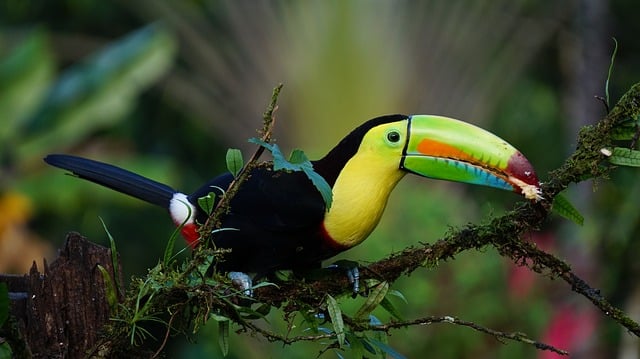
You can read the entire article or jump to any section:
The Amazon
The Amazon is a vast region that spans eight rapidly developing countries in South America: Brazil, Bolivia, Peru, Ecuador, Colombia, Venezuela, Guyana, Suriname, and French Guiana.
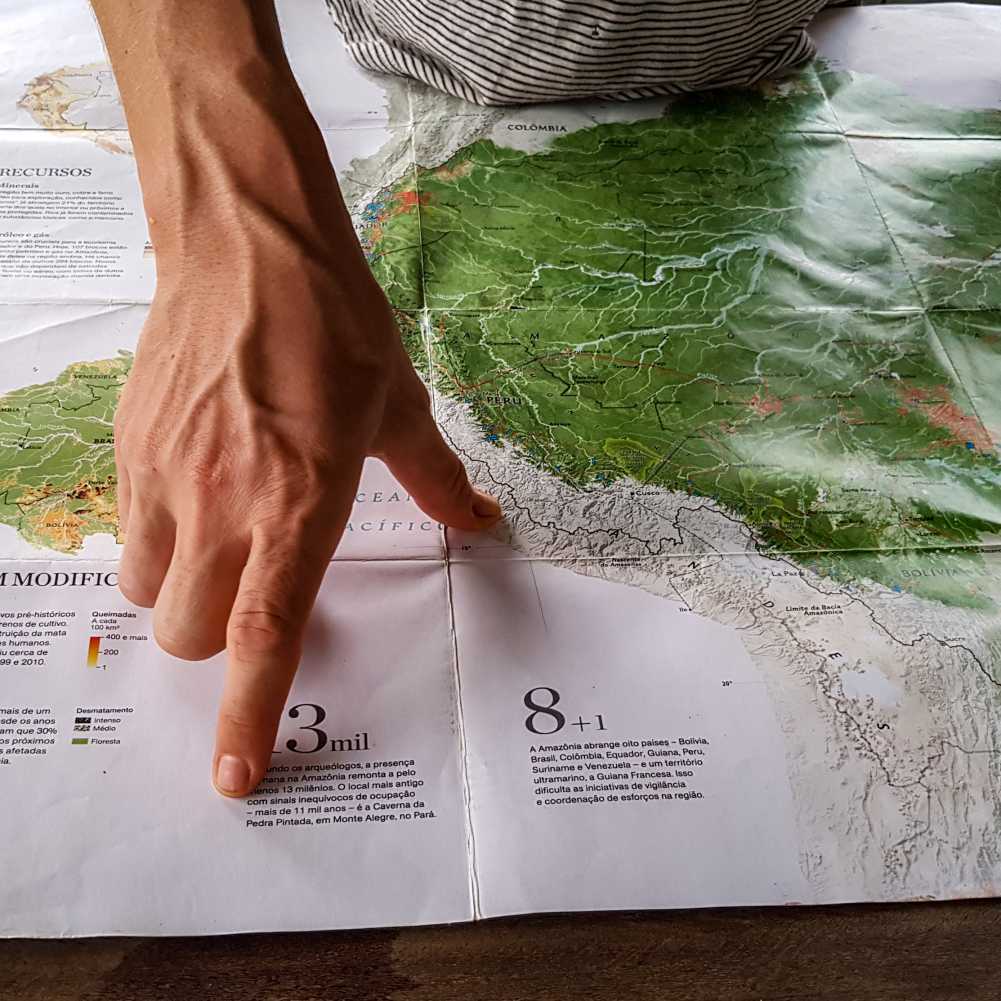
There is a lot to discover here!
Biodiversity
The Amazon is not only the largest remaining tropical rainforest on our planet, but it also claims the title of the most biodiverse place on Earth. Within its lush confines, it shelters a staggering 10% of the world’s known biodiversity, including unique and endangered plant and animal species.
The mighty Amazon River, stretching for over 6,600 kilometers, is the lifeblood of this extraordinary ecosystem. Its extensive network of tributaries and streams hosts the largest array of freshwater fish species found anywhere on Earth.
This biodiverse haven holds global significance. Each species within this rich tapestry of life offers solutions to a myriad of biological challenges, any one of which holds the potential to bring about transformative breakthroughs and generate substantial benefits for humanity on a global scale.
Why is the Amazon important?
The Amazon rainforest has long been recognized as a repository of ecological services not only for local people and communities but also for the rest of the world.

There is a clear link between the health of the Amazon and the health of the planet. The rainforests, which contain 90-140 billion metric tons of carbon, help stabilize local and global climate. Deforestation may release significant amounts of this carbon, which could have catastrophic consequences around the world.
For millennia, humans have used insects, plants and other organisms in the Amazon region for a variety of uses; agriculture, clothing and, of course, cures for diseases. The natural roots of the medicine that you find in your local pharmacy can be traced back to the biodiversity in the Amazon.
Indigenous communities like the Yanomami, as well as groups with mixed ancestry such as the mestizos in Peru and caboclos in Brazil, have honed the art of harnessing chemical compounds found in the rich biodiversity of plants and animals within their environments. Typically, this intricate knowledge of utilizing these natural resources is entrusted to a revered figure within the community known as the medicine man or shaman. The shaman imparts this sacred tradition to a chosen apprentice, ensuring the continuation of this invaluable heritage.
This timeless process of passing down wisdom and practices from generation to generation has persevered for centuries, becoming an integral and inseparable part of these people’s identities. It not only sustains their physical well-being but also strengthens their profound connection to the natural world that surrounds them.
Culture of the Amazon
According to the Coordinator of Indigenous Organizations of the Amazon Basin (COICA), the Amazon region is still home to about 9% of its population, totaling approximately 2.7 million people, who are primarily indigenous. Among this remarkable diversity, there are an astounding 350 distinct ethnic groups, with over 60 of them living in relative isolation.

The largest indigenous tribe in the Amazon, the Guarani, comprises 51,000 individuals, but they find themselves facing a significant land challenge. Over the past century, nearly all of their ancestral territories have been taken from them, transformed into extensive networks of cattle ranches, soybean fields, and sugar cane plantations.
In contrast, the Yanomami, a relatively isolated group, inhabit the largest territory, covering an impressive 9.4 million hectares in the northern Amazon, with a population of 19,000. In Brazil, the Tikuna tribe is the largest Amazonian tribe, numbering 40,000 members. Conversely, the smallest group consists of just one man, living in a small forest enclave surrounded by cattle ranches and soybean plantations in the western Amazon, along with a few others who remain elusive to contact.
Beyond Brazil, other countries within the tropical rainforest belt, including Bolivia, Ecuador, Peru, Colombia, the Guyanas, Venezuela, and Suriname, are also home to indigenous communities deeply rooted in the rainforest. These communities possess extensive knowledge of rainforest species, which they utilize for various purposes, including food, textiles, and traditional medicines.
The indigenous people of the Amazon play a vital role in preserving their environment. They possess extraordinary expertise in local flora and fauna and have developed ingenious methods for harnessing the forest’s biodiversity over countless generations. Their profound connection to the rainforest is a testament to their enduring stewardship of this precious ecosystem.
Climate change
In recent decades, the Amazon biome has experienced a troubling shift towards drier conditions, rendering the once nearly fireproof rainforest vulnerable to devastating wildfires. This transformation has been accompanied by a surge in extreme weather events, including soaring temperatures, prolonged droughts, and destructive floods, further exacerbating the challenges faced by this vital ecosystem.
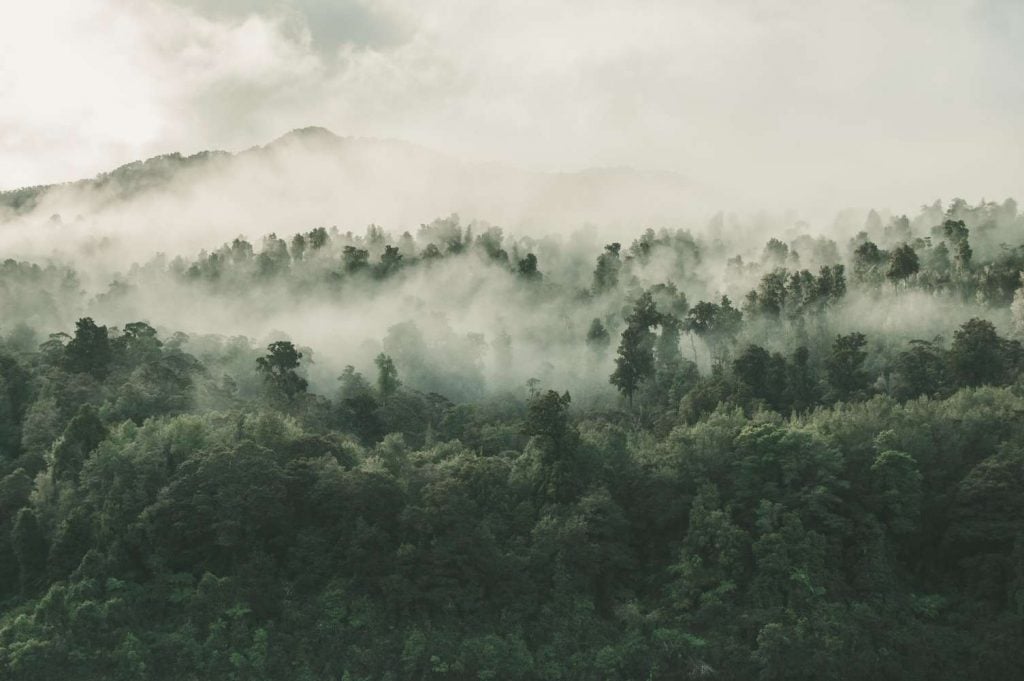
Researchers say that the very wet hydrological cycle that kept the rainforest thriving for millennia is under threat, with the biome enduring greater and greater stress and instability due to worsening deforestation and escalating climate change.
The Amazon holds a vast store of carbon in its plants and soil, so deforestation would not only be a disaster for the region’s biodiversity and its indigenous and traditional peoples who rely on it for their livelihoods, it could also escalate our current global climate catastrophe.
Animals of the Amazon
The Amazon is our planet’s Garden of Eden, where you’ll find a dazzling array of fascinating, bizarre, and even deadly animals. In total, scientists estimate there are 2,000 species of birds and mammals here, more than 2,000 species of fish, over 400 amphibians, and almost an equal number of reptiles. If you’re into animal spotting, then you really couldn’t pick a better place to visit!
Here is our list of top Animals of the Amazon to see:
1. Three-toed sloths
One of the strangest creatures on earth, sloths are insanely slow at just about everything. The three-toed sloth is possibly the cutest animal you will ever see, as well as the slowest: they are so slow that algae grow on their coats, allowing them to blend in and hide from predators.
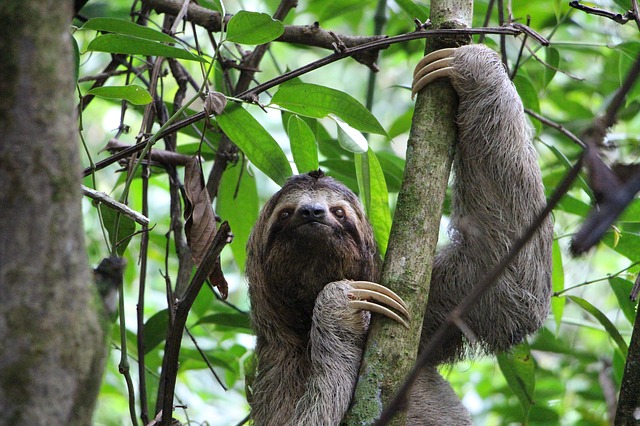
Found in the treetops of the Amazon Rainforest, these lazy creatures prefer to spend their days hanging by their powerful claws from a tree branch, often sleeping. During the night, you may see some activity from these mammals, who tend to eat fruit, leaves, and shoots during the night.
Three-toed Sloth Quick Facts:
- Sloths sleep for 15-20 hours a day
- They are great swimmers thanks to their long arms
- Three-toed sloths have a very distinctive cry that sounds a bit like “Ahh-eeee”
- It takes them a month to digest a meal (and you thought your metabolism was slow!)
Where can you go to spot a three-toed sloth?
The Tambopata National Reserve is home to 632 species of birds, 1200 butterfly species, 103 amphibians, 180 kinds of fish, 103 reptiles, and 169 different mammals. The reserve’s lake systems and forests provide the ideal habitat for several endangered species of Amazon animals, including the three-toed sloth!
Sloths may be hard to spot at first, but with an experienced guide and a keen eye, you should have no problems zeroing in on at least one during your journey. The good news? You have all the time in the world to photograph them once you find one!
2. Giant river otters
The Amazon is home to the largest otter in the world. The Giant River Otter can grow up to the length of 1,5 meters and is native to Central and South America. One of the most endangered of all Amazon Animals, due to overzealous hunting, the best chance of seeing Giant River Otters is on an Amazon River cruise in Peru.
Those who get the opportunity to observe this endangered creature are very fortunate indeed. In fact, Tambopata is one of the only places on Earth where this fantastic, large mammal can be seen easily.
Giant Otter Quick Facts:
- Giant river otters, often referred to as river wolves, share some striking similarities with their canine counterparts. Much like wolves, these otters lead complex social lives, forming tight-knit family groups that can consist of up to 20 members. These family-oriented creatures prefer to stick together, spending the majority of their time as a unit.
- Sadly, there are only around 5,000 Giant Otters remaining in the wild, making them an exceedingly rare sight. Their numbers have dramatically declined due to factors such as fur hunting, deforestation, and human disruption.
- One remarkable feature of Giant Otters is their unique cream-colored throat patches, each bearing a distinct shape and pattern. These beautiful markings serve as individual identifiers among the otters.
- Beyond their size, giant river otters possess a vast vocabulary. Adult otters communicate through an impressive repertoire of 22 distinct sounds, each carrying a specific message. From short barks and snorts to signal alarm to low growls as a warning, these otters are truly masters of communication in their watery world.
Where can you go to spot a Giant River Otter?
Rainforest Expeditions offers an excellent opportunity to encounter Giant River Otters. Lucky for you, Giant River Otter makes their home at Tres Chimbadas Lake, accessible from the Rainforest Expedition Posada Amazonas lodge!
When you visit the oxbow lakes near the Rainforest Expeditions lodges, you’ll get an unparalleled chance to view Giant Otters. This thrill is the result of cautious guides who are dedicated to ensuring a peaceful, undisturbed habitat for these shy, beautiful animals.
3. Black Caiman
The infamous Black Caiman is the largest predator in the Amazon basin and is known for their black, scaly skin. They are usually found in the slow-moving rivers and lakes in the Amazon region, as well as in the floodplains of the Amazon Rainforest.
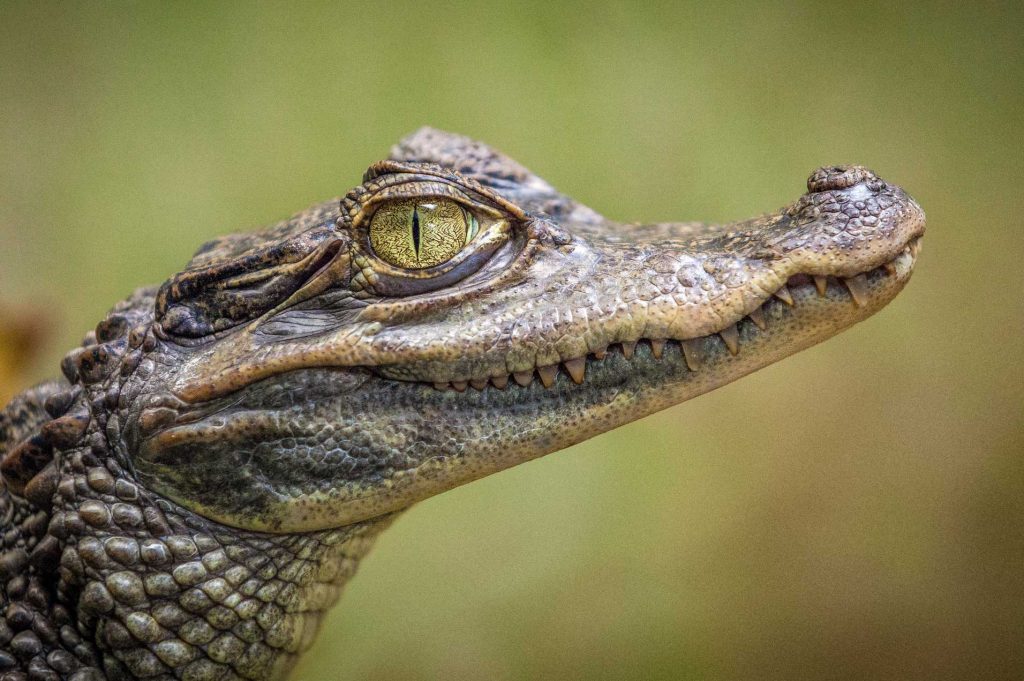
This formidable giant predator primarily prowls under the cover of night, capitalizing on its sleek black body to seamlessly blend into the obscurity of the nocturnal sky and the inky waters. Its diet mainly consists of catfish, piranhas, birds, turtles, and capybaras. However, large black caimans are known to be formidable hunters, capable of taking down tapirs, anacondas, jaguars, pumas, and even, on rare occasions, humans!
Fortunately, the Amazon region is home to a healthy population of these imposing creatures, and they are currently considered to be at “low risk” of extinction. It is estimated that there are between 25,000 to 50,000 black caimans residing in the wild, ensuring their continued presence in this remarkable ecosystem.
Black Caiman Quick Facts:
- A Black Caiman is massive – measuring up to 20 feet long.
- They can live for up to 80 years.
- They love to be warm: black caimans keep warm by basking in the sun and letting their dark scales soak up the sun.
- Black caimans have no real predators in their native homes. They are the apex animals. Even big cats, like jaguars and cougars, will avoid the lakes and swamps where the black caimans live.
- Though they’re classified as “least concern” now, it wasn’t always that way. Black caimans used to be hunted and killed for their scales, which were used in fashion. Up to 99% of black caimans were killed. Fortunately for the black caiman and animal lovers worldwide, their numbers have been brought back up.
Where can you go to spot a Black Caiman in the wild?
Rainforest cruises are one of the best operators to contact to ensure you see a black caiman up close and personal!
4. Capybara
The Capybara is the largest (and cutest) rodent in the world, weighing up to 140 pounds (50kg). Their name is derived from the Tupi language, from the people who inhabited Coastal Brazil, and means “grass-eater.” This is because fully-grown Capybaras can eat up to 8 pounds of grass daily.
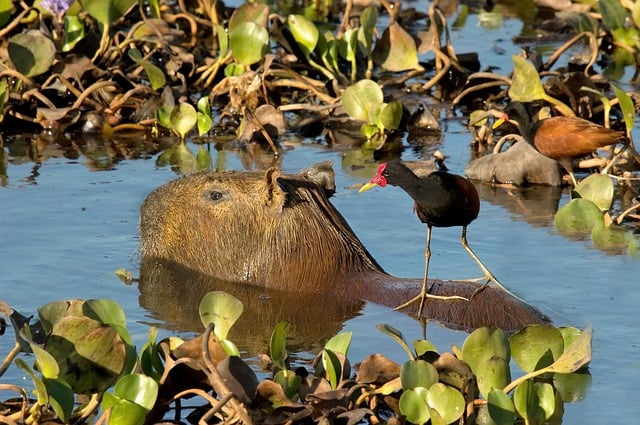
The natural predators of this Amazon Animal are jaguars, anacondas, and caimans, although humans still pose the largest threat as capybaras’ skin and meat are commercially traded.
Capybara Quick Facts:
- Capybaras enjoy swimming and have webbed toes to help them paddle through waterways easily. Swimming also helps them to escape possible predators, such as anacondas and jaguars.
- Capybaras are resting perch for numerous animals, such as birds and monkeys, who want a break from walking or flying. Capybaras don’t mind this and can be found grazing for food while another animal sits on their back.
- One Amazon tribe calls the capybara Kapiyva or “master of the grasses” in their native language.
Where can you go to spot the Capybara?
Rainforest Expeditions offers an excellent opportunity to encounter Capybaras. Nearly three in four visitors at Rainforest Expeditions see this world-record-shattering jungle rodent!
Coasting along the Tambopata River on the way to these lodges, you will travel through one of the most remote, biodiverse places: The Amazon rainforest. Among various riverbank wildlife, the Capybara is one of the most frequently sighted Amazon animals.
5. Pink river dolphins
Known as the Amazon River Dolphin, the Pink River Dolphin is among the select few dolphin species that thrive exclusively in freshwater habitats. This remarkable species calls the Amazon and Orinoco river basins its home, with a particular preference for the extensive tributaries, lakes, and seasonally flooded forests that characterize these regions.
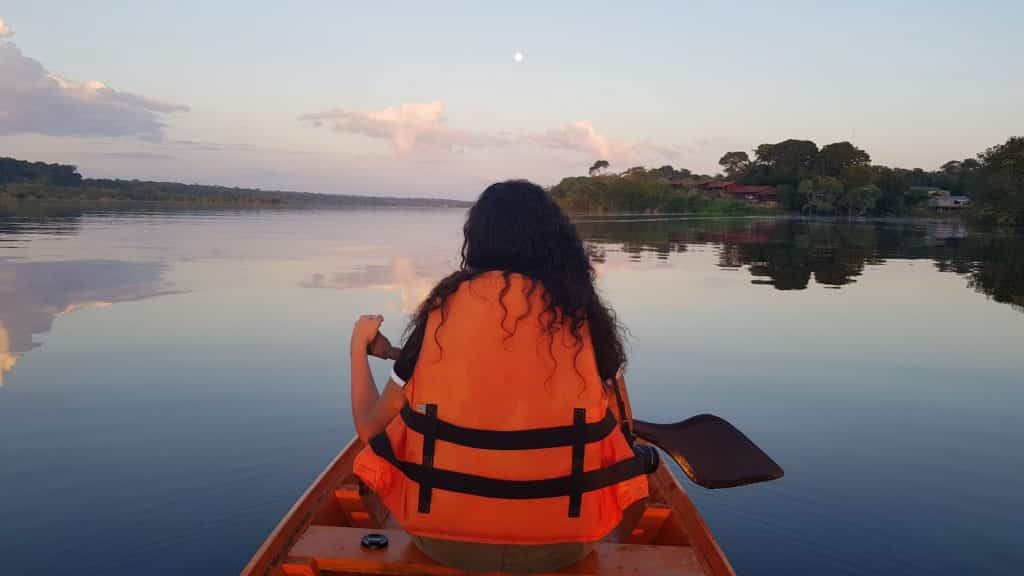
The Amazon River Dolphin looks remarkably different from its more familiar, ocean-faring cousin: with a pale pink body, an elongated neck, a long snout reminiscent of a beak, and a rounded head.
Like many other aquatic Amazon Animals, the Dolphin is threatened by pollution and various development projects, such as hydroelectric and irrigation schemes, which restrict the river’s natural flow. The River Dolphins have traditionally been spared from tribal hunting because they were believed to be magical creatures. But these days, Dolphins are often struck by fishermen’s boats or get tangled in fishing nets.
Pink River Dolphin Quick Facts:
- They hold the distinction of being the largest and most widely distributed river dolphin species on the planet.
- What sets the Pink River Dolphins apart from their aquatic counterparts is their unique ability to flex their necks, allowing them to move their heads from left to right with remarkable flexibility.
- In their natural habitat, Pink River Dolphins can lead a lengthy existence of up to 30 years. However, their fate in captivity tells a different story, with an average lifespan of less than two years under such conditions.
- In the rich tapestry of tribal folklore, there exists a captivating legend surrounding these dolphins, also known as boto. According to local beliefs, Pink River Dolphins possess the extraordinary power to transform into handsome men who can seduce and impregnate women. This intriguing myth has given rise to a cautious attitude among locals when a charming stranger arrives in town, prompting them to consider the possibility of encountering a shape-shifting dolphin in human form!
Where can you go to spot Pink River Dolphins?
It isn’t easy to find tours and operators that allow you to experience pink dolphins in their natural habitat without handling them. Interacting physically with wildlife can harm them, so it is good to avoid operators that don’t have an ethos for conservation and only exploit animals to get money from tourists.
Uniq Hotels offers the opportunity to stay in the Jungle Palace – the first floating eco-friendly luxury hotel! This sustainable hotel (with modern, luxurious amenities) is situated right on the Rio Negro, close to the City of Manaus in the center of Brazil’s Amazon Rainforest. It can’t get much better than that.
If you are on a river cruise or staying on the river, you should be able to see Pink River Dolphins if you are quiet. My recommendation would be to do what I did to spot them – grab a boat or a canoe and row out onto the river at sunrise. Then you will be rewarded with the most spectacular sight of pink dolphins in their natural habitat – unharmed and untouched by tourism companies.
If you want to learn more about Dolphins, look at the most comprehensive article about the Best Places to swim with Dolphins.
6. Jaguar
They are the only big cat in the Americas and the third biggest in the world after tigers and lions. They look a lot like leopards, which live in Africa and Asia, but jaguars’ spots are more complex and often have a dot in the center of their rosettes (the spots on their coats).
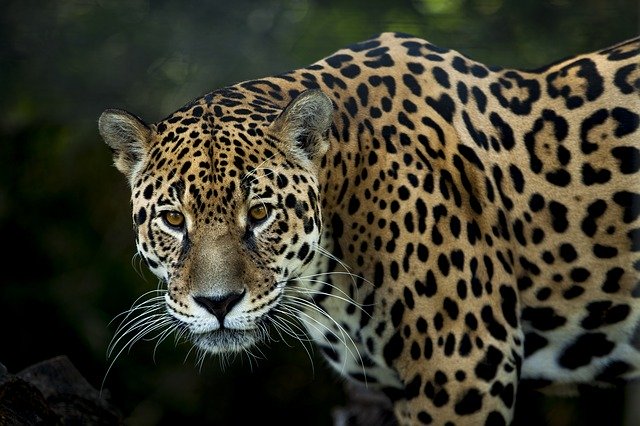
According to the International Union for Conservation of Nature’s Red List of Threatened Species, the jaguar is “near threatened” due to poaching and rainforest destruction. Jaguars face several threats, including habitat fragmentation and illegal killing.
Jaguar Quick Facts:
- The jaguar is a top-level predator. It has no natural predators other than humans, who hunt them for their fur or sport.
- Their name comes from the Native American word “yajuar” which means “he who kills with one leap.”
- Jaguars can see six times better than humans at night or during darker conditions. This is due to a layer of tissue in the back of the eye that reflects light.
- Unlike many other cats, jaguars do not avoid water. They are pretty good swimmers.
- Jaguars live alone, and they’re very territorial.
- These powerful cats were worshipped as gods in many ancient South American cultures. The jaguar’s representation appears in the art and archaeology of pre-Columbian cultures across the jaguar’s range.
Where can you go to spot a Jaguar?
Natural World Safaris offer the best safaris to maximize your chances of seeing these elusive big cats.
Take a boat ride on the river. For the best chance of a sighting, go towards the end of the dry season (June to October). This is when the floods have receded, and the predators head to the riverbanks to hunt capybara and caiman.
7. South American Tapir
There are four recognized species of tapirs: Baird’s tapir, Mountain tapir, Malayan tapir, and Brazilian tapir. The Malayan tapir is the largest, and the Mountain tapir is the smallest. All recognized tapirs are classified as vulnerable or endangered by the IUCN.
The Brazilian tapir, or South American tapir, is the largest land mammal in the Ecuadorian and Peruvian Amazon – they can grow up to 6.5 feet long and weigh up to 550 pounds. But this extraordinary animal still moves quickly on land, and they are excellent swimmers. Deforestation and hunting are the main threats to Tapir’s survival.
Tapir Quick Facts:
- The tapir’s nose is flexible. While this prehensile snout is not as flexible as an elephant’s trunk, it’s very good for snuffling around and grabbing leaves and fruit.
- Secondly, they like to swim and stay close to water to cool down and remove parasites.
- Thirdly, they use their snouts as snorkels to hide underwater from predators.
- Tapirs are considered living fossils. They’ve been around since the Eocene, having survived several waves of extinction.
- Tapirs are nocturnal, hiding in thick forest patches to sleep most of the day. So a night walk would be a great way to ensure an encounter with this Amazon Animal.
Where can you go to spot Tapirs?
Tapir Valley offers a Jungle Night Tour that is perfect for spotting Tapirs. You never know what you may see. You’ll never forget the sights and sensations of nightfall in a pristine, private rainforest. While sightings of the endangered tapir are rare, the animal is nocturnal. Finding evidence of presence is especially thrilling at night. Especially when you know it’s active in the forest, just as you are.
Hiring a local guide during your visit to Tapir Valley supports the work of Bijagua naturalists. As well as providing you with deeper insight into the area. The guides share a profound knowledge of local history, geography, and culture. Through years on the trail, they have developed the skills to identify numerous bird calls, wildlife, and plants.
8. Squirrel Monkeys
Squirrel monkeys are the most common monkey found in the Amazon region. These tree-dwelling monkeys are mostly shy creatures. They are very quiet but sometimes squeak and shriek loudly if they are in danger.
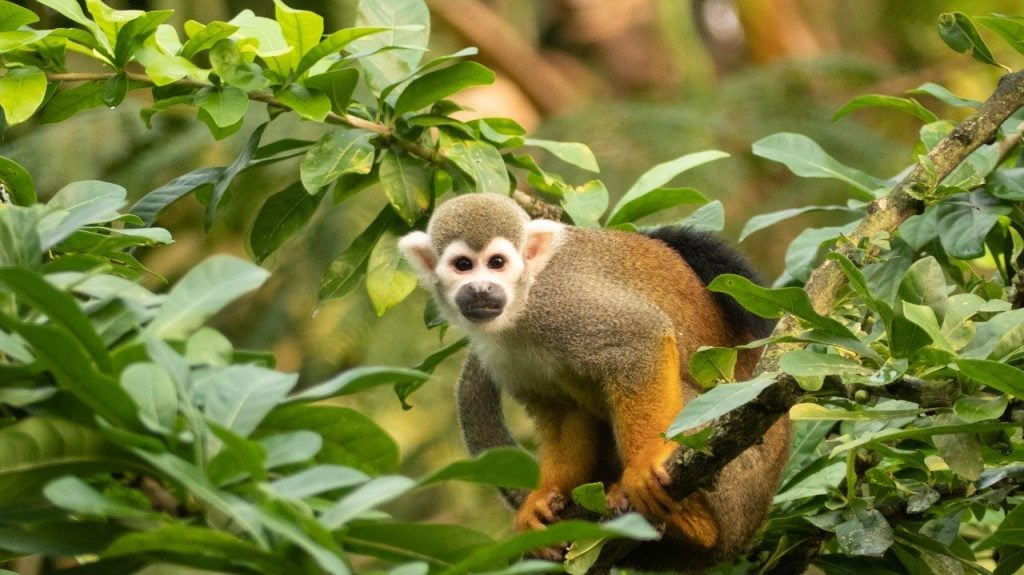
Most squirrel monkeys can be spotted in the tree canopies of the Amazon Rainforest, but you may be lucky enough to see one on the ground in search of food. You can usually spot a squirrel monkey by its distinctive black lips and white ears.
Squirrel Monkey Quick Facts:
- Their tails can be as long as 17 inches!
- They have a 1:17 brain mass to body mass ratio – the largest, proportionally, of all primates! Humans have a 1:35 ratio.
- Unlike most other New World monkeys, they can’t use their tail for climbing.
- The fur on their face is black and white, making them vaguely resemble a skeleton. For this reason, the German name for Squirrel Monkeys is Totenkopfaffen, meaning “Death’s Head Monkey.”
Where can you go to spot Squirrel Monkeys?
Join Nat Hab on one of their many specialized tours throughout the Amazonian rainforest to spot squirrel monkeys in the wild!
Summary of Animals in the Amazon
Many people travel to the Rainforest to see Amazon Animals, expecting to see jaguars, anacondas, and giant otters swimming around their boats. The truth is that the Amazon is a habitat where animals often disguise themselves for protection from predators. To spot wildlife, you need to be very quiet and patient.
One must remain calm, be patient, and let the jungle come to you. The experience is not only predicated on sightings of megafauna. It also takes in the beauty and magic of the ecosystem itself. And what is certain is that you will see elements of the Natural World that will never be forgotten!
We have listed 8 Top Amazon Animals to encounter and the best operators to use when searching for them. The Amazon is essential to protect. Your choice of which tourism operators you support can impact the Amazon Animals.
- Top 5 Rarest Animals in the World - April 15, 2024
- Mongoose Meets One Of The Deadliest Snakes Alive - April 8, 2024
- Watch: Komodo Dragon Swallows Baby Goat In Seconds - March 28, 2024

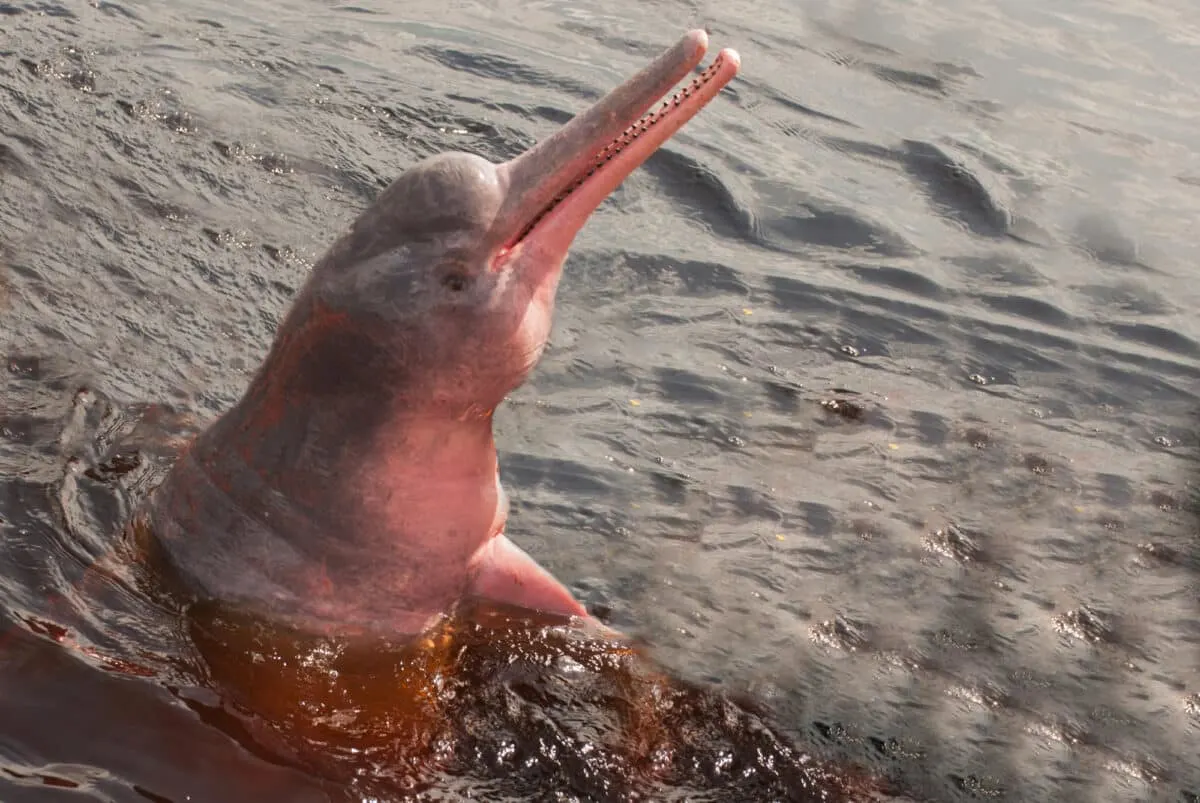



Ashleigh Heath
Monday 29th of June 2020
I was today years old when I learnt that sloths can swim. Very well written article!